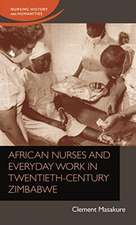Genomics of Pain and Co-Morbid Symptoms
Editat de Susan G. Dorsey, Angela R. Starkweatheren Limba Engleză Paperback – 16 iun 2020
This book's structure leads the reader through the physiology of pain and genomics into how pain is studied, mechanisms of acute and chronic pain, various protocols that are used throughout the field along with the pros/cons of the current methods used, and project into the future of pain genomics. This work is intended for classroom teaching, for nurses, for novice researchers in symptom science and pain research as well as students and postdoctoral fellows.
Preț: 461.91 lei
Preț vechi: 486.21 lei
-5% Nou
Puncte Express: 693
Preț estimativ în valută:
88.38€ • 92.53$ • 73.13£
88.38€ • 92.53$ • 73.13£
Carte tipărită la comandă
Livrare economică 07-21 aprilie
Preluare comenzi: 021 569.72.76
Specificații
ISBN-13: 9783030216566
ISBN-10: 303021656X
Pagini: 248
Ilustrații: IX, 255 p. 17 illus., 15 illus. in color.
Dimensiuni: 155 x 235 mm
Greutate: 0.38 kg
Ediția:1st ed. 2020
Editura: Springer International Publishing
Colecția Springer
Locul publicării:Cham, Switzerland
ISBN-10: 303021656X
Pagini: 248
Ilustrații: IX, 255 p. 17 illus., 15 illus. in color.
Dimensiuni: 155 x 235 mm
Greutate: 0.38 kg
Ediția:1st ed. 2020
Editura: Springer International Publishing
Colecția Springer
Locul publicării:Cham, Switzerland
Cuprins
Chapter 1. Pain physiology (defining acute and chronic pain).- Chapter 2. Neurobiology of nociception (anatomy of ascending and descending systems).- Chapter 3. Genetics of pain and co-occuring symptoms.- Chapter 4. Sex differences and pain genomics.- Chapter 5. Systems biology/multi-omis approaches to pain and co-occuring symptoms.- Chapter 6. Pre-clinical rodent models of pain for genomics studies.- Chapter 7. Clinical models of experimental pain for genomics studies.- Chapter 8. Clinical pain genomics research.- Chapter 9. Pain phenotyping (methods, measures).- Chapter 10. Precision health and pain genomics.- Chapter 11. Exemplars of pain genomics studies (could be multiple chapters).- Chapter 12. Roadmap to translation of pain genomics.
Notă biografică
Susan G. Dorsey, PhD RN FAAN, is a professor of nursing and chair in the Department of Pain and Translational Symptom Science, at the University of Maryland School of Nursing. She received her PhD from the University of Maryland, Baltimore and completed a postdoctoral fellowship at the National Cancer Institute in the Mouse Cancer Genetics Program. She holds secondary faculty appointments in the School Of Medicine Department of Anesthesiology and the School Of Dentistry’s Neural & Pain Sciences Department. She co-directs the campus-wide Center to Advance Chronic Pain Research and serves as a Multiple Principal Investigator (MPI) for a newly awarded NINR-funded P30 Center, Omics Associated with Self-management Interventions for Symptoms (OASIS). In 2015, Dr. Dorsey was appointed as a translational research expert on the NCI Symptoms and Quality of Life Steering Committee and served as co-chair for the 2017 NCI Clinical Trials Planning Meeting for chemotherapy-induced peripheral neuropathy. Dr. Dorsey’s translational program of research incorporates molecular, cellular and genetic/genomic methods to study chronic pain and cancer treatment-related neuropathic pain and related symptoms.
Angela Starkweather is an acute care nurse practitioner and neuroscience nurse with 20 years of experience managing pain in acute and urgent care settings, who has devoted her career toward identifying the physiological mechanisms of persistent pain and developing personalized methods to mitigate pain and its detrimental consequences. The impact of her research has led to innovative self-management strategies for patients and families dealing with pain and other distressing symptoms. She has been funded by the National Institute of Nursing Research for the past 10 years and serves as the Director of the Center for Accelerating Precision Pain Self-Management at the University of Connecticut School of Nursing. She is past-Chair of the Genomic Nursing andHealth Care Expert Panel of the American Academy of Nursing, and serves as an Ambassador of the Friends of the National Institute of Nursing Research, and standing member of the American Association of Neuroscience Nurses Clinical Practice Guidelines Board.
Textul de pe ultima copertă
This book provides an overview of the field of pain genomics and the genomics of related, or co-occuring, symptoms, the current state-of-the-science, and challenges that remain. It brings differing views in the field together and provides examples of translational science from using cellular and rodent models to human clinical trials.
This book's structure leads the reader through the physiology of pain and genomics into how pain is studied, mechanisms of acute and chronic pain, various protocols that are used throughout the field along with the pros/cons of the current methods used, and project into the future of pain genomics. This work is intended for classroom teaching, for nurses, for novice researchers in symptom science and pain research as well as students and postdoctoral fellows.
Caracteristici
Offers examples of Research programs in pain genomics, often led by nurse scientists Provides examples of research protocols and clinical protocols Links the work done in basic research to clinical practice in pain genomics Designs to meet nurses' educational needs



























